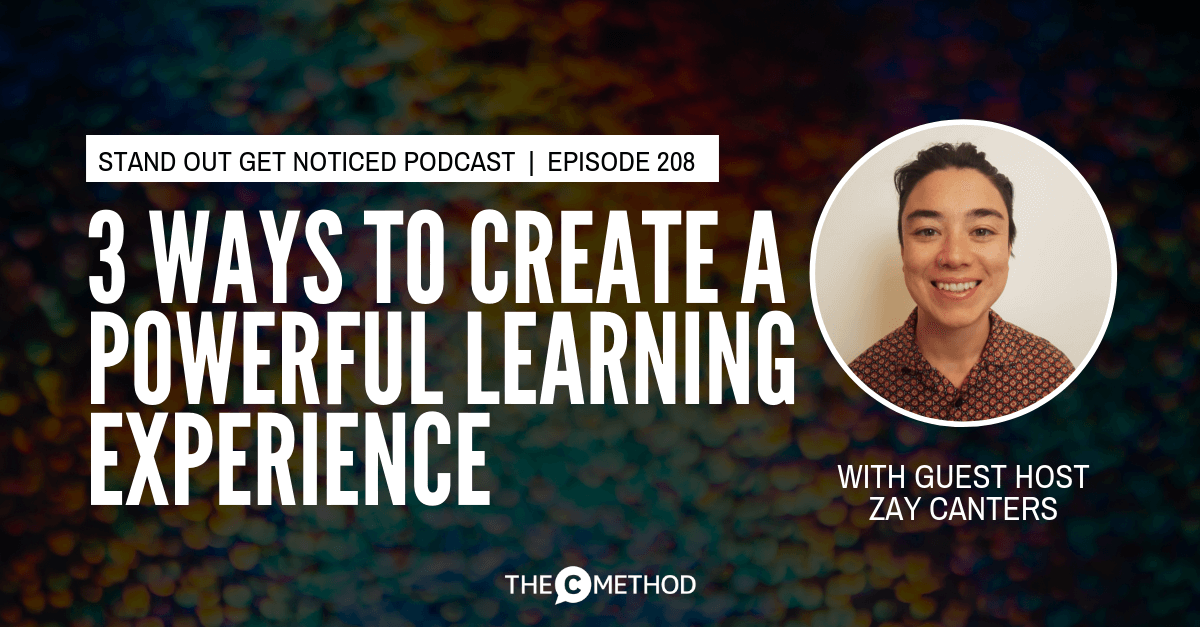This podcast content is for members of The C Method Academy only. The C Method Academy is our monthly members-only training and accountability program. Members get access to exclusive podcast content, Masterclass 'mini courses', Live Coaching Calls and our private community platform. If you want to rapidly develop your confidence, communication and leadership skills, I invite you to join us! Click here to learn more and join The Academy

Want to create a powerful learning experience for your audience?
Hey, my name is Zay Canters, and this week I’ll be taking over the podcast from Christina as she’s on her honeymoon with her husband!
When you are the trainer, the last thing you want your audience to do is switch off, resist your message or distrust you. Here are two reasons why this disconnect can occur:
- You may be sharing content that is at a level that your audience is not at yet or not ready for. If you want to learn more about how to plan your presentation to suit your audience, listen to podcast episode 98 How to plan your presentation, where Christina talks about understanding your audience and gives you an epic presentation template that you can download. I use this presentation template to help me plan my workshops, it’s awesome!!
- Your audience may be at a particular level of thinking, psychologically and you are communicating with them too far ahead of their thinking. It’s important to know where your audiences collective thinking is at, because the more you understand and calibrate your audience, the better you will be at communicating with them in a way in which they understand and connect with.
What is a powerful learning experience?
- When we learn something new. Something that is related to us and what we care about and something that we can actually implement into our lives.
- Where we connect to other people, create new friendships, and find people who have the same values as us.
- Where we learn something about ourselves which we didn’t know before!
3 Ways to Create a Powerful Learning Experience
1. Build Trust
When people are in a level of distrust, it’s all about survival, they do not connect with other people, they are generally responding to fear, the fear of being judged, being rejected, not being loved, it’s the fear of not being worthy. It’s challenging for people in a state of distrust to comprehend or actually learn any useful information because they are focusing purely on survival, on just getting through, generally they are thinking about themselves and when they are thinking about themselves they are not capable of thinking about anything or anyone else. So we need to build their trust before we teach them anything or give them any information.
How do we do that?
- Acknowledge where they are at. When you acknowledge where they are at, you are showing them respect, you are showing them that you see them, you are showing them that you care about them.
- DON’T start off by talking about yourself, and how awesome you are and why they should be listening to you. People in a state of distrust don’t care about you or what you do, they just want to know about how you can help them.
2. Create Relatability
When your audience is in a state of relatability they start to trust you and they start to trust the others in the group.They start to loosen up a bit, they start to connect and talk to each other, they begin to have a little bit of fun. What we are wanting to create with relatability is for your audience to be thinking “Huh! Yeah right, I like these people, we’re kinda the same as each other!” This is a really cool space to be in because in this state, they are not worried about themselves anymore, they are becoming more receptive to learning and comprehending new information.
How do we do that?
- Start a conversation with the group about something that brings together their commonality. It could be about where they are from, it could be about what they are wanting to get out of being in the room.
3. Cultivate Uniqueness
Cultivating uniqueness is all about helping your audience find their individuality, helping them believe in their own power and ability to do something. It’s about discovering more of who they are, what they care about, and what they’re good at. The thinking that you want to cultivate in your audience is “I’m starting to feel like I can do this! I reckon this is for me!”
How do we do that?
- Teach small chunks that are just one step ahead of where they are currently at.
- Engage your audience and help them to connect to your message and relate it to their lives by asking questions.
“What is it that you are finding useful?” - Ask questions to spark taking action…
“What are you going to DO as a result of the things we just learned?” - Share with your audience some powerful messages that can help them get to this point.
Eg. The more you think about doing something without doing it, the more your self-esteem will decrease. You have to start before you’re ready. Imperfect action is better than perfect inaction or no action at all.
Connect with Zay:
- Join the How I Quit Drinking Alcohol FB Group: https://www.facebook.com/groups/HIQDA/
- Check out Fearless Movement Collective: http://fearlessmovement.co
Leave a Reply